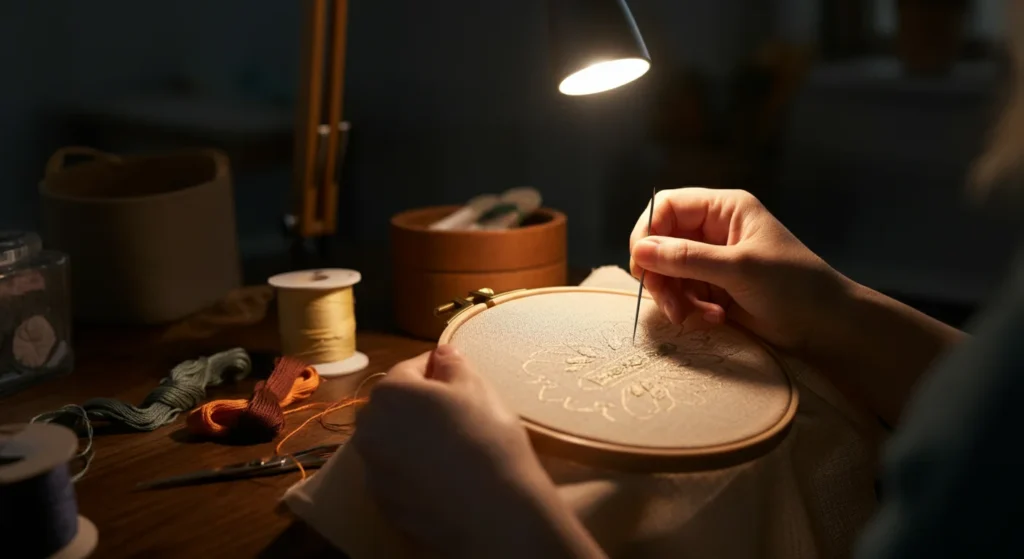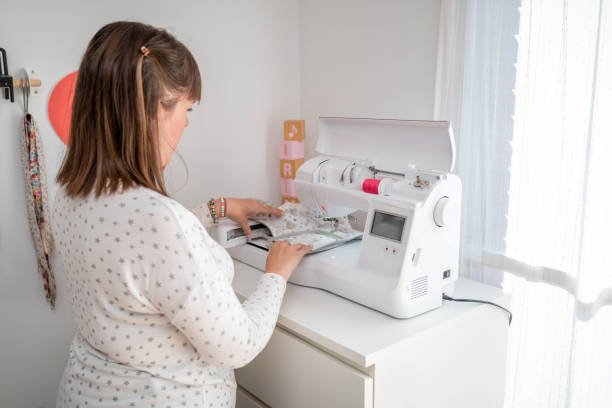Ready to turn your embroidery hobby into a lucrative income stream? Starting a home embroidery business offers creative individuals an incredible opportunity to transform their passion into profit while maintaining the flexibility to work on their own terms.
The embroidery industry has experienced remarkable growth, with the global embroidery market projected to reach significant heights as consumers increasingly seek personalized, handcrafted items. This surge in demand for custom apparel, home decor, and unique gifts creates the perfect environment for aspiring entrepreneurs to launch their own home embroidery business.
What makes an embroidery business particularly attractive is its low barrier to entry combined with high profit potential. Unlike many traditional businesses that require substantial upfront investment, you can start an embroidery business from home with minimal equipment while enjoying profit margins that often exceed 60% on custom orders.
This comprehensive guide will walk you through every essential step of How to Start a Small Embroidery Business From Home, from assessing your skills and defining your niche to marketing your products and managing finances. Whether you’re a stay-at-home parent seeking flexible income opportunities or a creative individual looking to monetize your crafting skills, you’ll discover actionable strategies to turn your embroidery passion into a thriving business venture.
Assess Your Embroidery Skills and Define Your Niche

Before diving into the business aspects, conduct an honest evaluation of your current embroidery abilities. Understanding your skill level helps determine what services you can confidently offer and identifies areas for improvement.
Start by cataloging your existing embroidery techniques. Can you execute basic stitches like running stitch, backstitch, and French knots? Are you comfortable with more advanced techniques such as satin stitch, chain stitch, or specialty thread work? Document your capabilities across different embroidery styles, including hand embroidery, machine embroidery, and mixed-media approaches.
Finding Your Profitable Niche
The embroidery market spans numerous categories, making niche selection crucial for success. Popular niches include:
Custom Apparel: Personalized t-shirts, hoodies, hats, and jackets for individuals, sports teams, and businesses. This niche offers steady demand and recurring customers.
Wedding and Special Events: Bridal accessories, ring pillows, handkerchiefs, and custom linens command premium prices due to their sentimental value and one-time nature.
Home Decor: Embroidered pillows, wall art, table runners, and kitchen textiles appeal to homeowners seeking unique decorative pieces.
Baby and Children’s Items: Personalized blankets, bibs, clothing, and nursery decor represent a consistently growing market with high emotional value.
Corporate and Promotional Products: Business logos on shirts, bags, and accessories provide bulk order opportunities with reliable profit margins.
Research your local market to identify underserved niches. Visit craft fairs, browse online marketplaces like Etsy, and analyze competitor offerings to spot gaps you could fill with your unique style and expertise.
Developing Your Signature Style
Creating a recognizable aesthetic sets your embroidery business apart from competitors. Experiment with different color palettes, thread types, and design approaches to develop a signature style that reflects your personality and appeals to your target market.
Consider specializing in specific techniques such as modern minimalist embroidery, vintage-inspired designs, or contemporary mixed-media approaches. Document your style evolution through photos and notes, building a portfolio that demonstrates your unique artistic voice.
Develop a Detailed Business Plan
A comprehensive business plan serves as your roadmap to success, helping you make informed decisions and secure funding if needed. Your embroidery business plan should address several key components.
Market Analysis and Target Customers
Identify your ideal customers by creating detailed buyer personas. Consider demographics, interests, spending habits, and pain points your embroidery services can solve. For example, busy professionals might value custom corporate gifts, while new parents seek personalized baby items.
Research your competition by analyzing local embroidery shops, online sellers, and craft fair vendors. Note their pricing strategies, product offerings, and marketing approaches to identify opportunities for differentiation.
Pricing Strategy and Financial Projections
Develop a pricing structure that covers materials, labor, overhead, and profit. Calculate your hourly rate by considering your skill level, local market rates, and desired income. Factor in thread costs, fabric expenses, machine maintenance, and business overhead when setting prices.
Create realistic financial projections for your first year, including startup costs, monthly expenses, and revenue goals. Account for seasonal fluctuations in demand and plan for gradual business growth as you build your customer base.
Many successful home embroidery businesses start with modest monthly revenues of $500-$1,000 but can scale to $3,000-$5,000 monthly as they establish their reputation and expand their offerings.
Legal Requirements and Business Structure
Starting an embroidery business from home requires attention to various legal considerations. Begin by obtaining a business license from your local city or county office. This legitimizes your operations and may be required for certain business activities.
Apply for a sales tax permit if you’ll be selling products directly to consumers. This allows you to collect sales tax on behalf of your state and ensures compliance with tax regulations.
Check local zoning laws to confirm that operating a home-based business is permitted in your area. Some residential zones have restrictions on commercial activities, customer visits, or signage that could affect your operations.
Understanding copyright laws is crucial for embroidery businesses. Ensure you have proper licensing for any designs you didn’t create yourself. Many embroidery designs require purchase or licensing fees, and using copyrighted images without permission can result in legal issues.
Consider obtaining business insurance to protect against potential liability issues. General liability insurance covers accidents that might occur during business operations, while product liability insurance protects against issues related to your embroidered items.
Set Up Your Home Embroidery Studio

Creating an efficient workspace is fundamental to your embroidery business success. Your home studio should balance functionality, organization, and comfort to support long hours of detailed work.
Essential Equipment and Tools
The cornerstone of your embroidery business is your embroidery machine. Entry-level machines suitable for small businesses range from $500-$1,500, while professional-grade machines can cost $2,000-$10,000 or more. Popular beginner-friendly options include Brother PE800, Janome Memory Craft series, and Singer Legacy machines.
Consider machine features such as embroidery area size, built-in designs, computer connectivity, and automatic threading capabilities. Larger embroidery areas allow for bigger projects, while computer connectivity enables custom design uploads.
Beyond your primary machine, invest in quality supplies including various thread types, stabilizers, hoops in multiple sizes, scissors, seam rippers, and marking tools. Organize supplies in clear containers or drawers for easy access and inventory management.
Software and Design Tools
Embroidery digitizing software converts artwork into machine-readable embroidery files. Popular options include Wilcom TrueSizer (free), Embrilliance Essentials ($149), and professional-grade Wilcom EmbroideryStudio ($1,000+).
Start with basic software to learn digitizing fundamentals, then upgrade as your skills and business needs grow. Many machines include basic editing software, which can suffice for simple modifications and text additions.
Workspace Organization
Dedicate a specific area of your home to embroidery work, ensuring adequate lighting, ventilation, and storage. Natural light is ideal for color matching, but supplement with quality task lighting for evening work.
Install proper storage solutions for threads, fabrics, and supplies. Thread racks, drawer organizers, and shelving systems keep materials accessible while maintaining a professional appearance for client visits.
Consider ergonomic factors such as chair height, table positioning, and monitor placement to prevent fatigue during long embroidery sessions. A comfortable workspace directly impacts productivity and work quality.
Market Your Embroidery Business Effectively
Successful marketing combines online presence with local community engagement to build brand awareness and attract customers.
Building Your Online Presence
Create a professional website showcasing your embroidery portfolio, services, and pricing. Include high-quality photos of your work, customer testimonials, and clear contact information. Platforms like Squarespace, Wix, or WordPress offer user-friendly website building tools.
Social media marketing is particularly effective for visual businesses like embroidery. Instagram and Facebook allow you to share work-in-progress photos, finished projects, and behind-the-scenes content that builds audience engagement.
Post consistently and use relevant hashtags to increase visibility. Engage with followers by responding to comments, sharing user-generated content, and participating in embroidery community discussions.
E-commerce Platforms
Online marketplaces provide immediate access to established customer bases. Etsy remains the most popular platform for handmade items, with numerous successful embroidery businesses showcasing personalized gifts, custom apparel, and unique home decor items.
Optimize your Etsy listings with detailed descriptions, multiple high-quality photos, and competitive pricing. Use Etsy’s advertising tools to increase visibility for your best-selling items.
Consider expanding to additional platforms like Amazon Handmade, Facebook Marketplace, or your own e-commerce website as your business grows.
Local Marketing Strategies
Participate in local craft fairs and markets to build community connections and gain immediate customer feedback. These events offer valuable opportunities to demonstrate your skills, network with other crafters, and establish local brand recognition.
Partner with local boutiques, gift shops, or wedding planners who might refer customers or carry your products on consignment. Building relationships with complementary businesses creates mutual referral opportunities.
Social media influencers in your local area or niche market can help expand your reach through authentic product endorsements and collaborations.
Manage Finances and Ensure Customer Satisfaction
Sound financial management and exceptional customer service form the foundation of sustainable business growth.
Financial Tracking and Inventory Management
Implement systems to track income, expenses, and inventory from day one. Simple spreadsheets can suffice initially, but consider upgrading to accounting software like QuickBooks or FreshBooks as transaction volume increases.
Monitor key metrics including average order value, customer acquisition cost, and profit margins per product category. This data helps identify your most profitable services and informs future business decisions.
Maintain adequate inventory levels for commonly used threads, stabilizers, and blank items while avoiding excessive stock that ties up capital. Many suppliers offer just-in-time ordering systems that balance availability with cash flow.
Customer Service Excellence
Exceptional customer service differentiates your business from competitors and generates valuable word-of-mouth referrals. Establish clear communication protocols for order inquiries, progress updates, and delivery schedules.
Create detailed order forms that capture all project specifications, reducing misunderstandings and ensuring customer satisfaction. Include fabric type, thread colors, size requirements, and completion timelines.
Handle customer complaints promptly and professionally. Most issues can be resolved through open communication and willingness to make adjustments when necessary.
Common Mistakes to Avoid
Avoid these pitfalls that often challenge new embroidery business owners:
Underpricing products is perhaps the most common mistake. Calculate all costs including materials, time, overhead, and desired profit margin. Don’t undervalue your skills and artistry.
Neglecting copyright laws can result in serious legal consequences. Only use designs you’ve created, purchased, or properly licensed. When in doubt, create original designs or purchase commercial-use patterns.
Failing to define your niche leads to unfocused marketing and inconsistent brand identity. Specializing in specific embroidery types or target markets makes marketing more effective and builds stronger customer relationships.
Ignoring customer feedback prevents business improvement and growth. Actively seek feedback and use it to refine your products, services, and processes.
FAQ About How to Start a Small Embroidery Business From Home
What are the best embroidery machines for beginners starting a home business?
For beginners, Brother PE800, Janome Memory Craft 500E, and Singer Legacy SE300 offer excellent value and features. These machines provide sufficient embroidery area, built-in designs, and user-friendly interfaces while remaining budget-friendly for new businesses.
How much can I expect to earn from a home embroidery business?
Earnings vary widely based on time invested, pricing strategy, and market demand. Part-time operations might generate $500-$2,000 monthly, while full-time businesses can achieve $3,000-$8,000 or more. Success depends on consistent marketing, quality work, and efficient operations.
Do I need special training or certification to start an embroidery business?
No formal certification is required, but developing strong embroidery skills is essential. Online courses, YouTube tutorials, and local workshops can help improve your techniques. Focus on mastering both hand and machine embroidery methods relevant to your chosen niche.
How do I protect my original embroidery designs from being copied?
Document your design process with dated sketches and photos. Consider registering original designs with the U.S. Copyright Office for maximum protection. Watermark digital images and clearly state usage rights when sharing designs online.
What’s the typical turnaround time for custom embroidery orders?
Most small businesses offer 7-14 day turnaround times for standard orders, with rush services available for additional fees. Complex or large orders may require longer timeframes. Clear communication about timelines prevents customer disappointment and sets appropriate expectations.
Transform Your Passion Into Profit
Starting a small embroidery business from home represents an exciting opportunity to blend creativity with entrepreneurship. The combination of low startup costs, high profit potential, and flexible working arrangements makes this venture particularly attractive for creative individuals seeking financial independence.
Success in the embroidery business requires dedication to developing your skills, understanding your market, and consistently delivering quality products that exceed customer expectations. The steps outlined in this guide provide a solid foundation for building a profitable home embroidery business.
Remember that business growth takes time and persistence. Start small, focus on quality over quantity, and gradually expand your offerings as you gain experience and build your customer base. Many successful embroidery entrepreneurs began with simple projects and evolved into thriving businesses serving hundreds of satisfied customers.
Take the first step today by assessing your current skills and defining your niche market. With careful planning, consistent effort, and attention to customer needs, your home embroidery business can provide both creative fulfillment and financial success for years to come.


